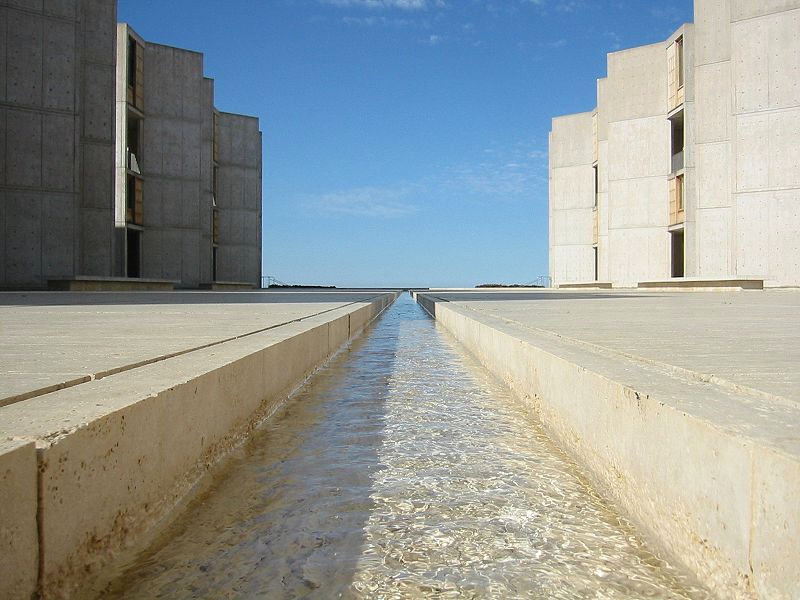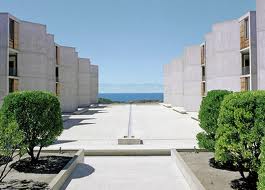
- •Unit 18 Architecture and Creativity
- •Inside a Salk Institute's study
- •Unit 19 Environmental Psychology
- •Circle in the list the words and expressions you know. Write down their translation in the table and calculate the percentage of your lexical competence.
- •Higher Thought
- •Natural Focus
- •Seeing the Light
- •A Room to Relax
- •Unit 20 The Power of Architecture
- •Circle in the list the words and expressions you know. Write down their translation in the table and calculate the percentage of your lexical competence.
Unit 18 Architecture and Creativity
1 Introduction2 interface
1.1 Read the text title and hypothesize what the text is about. Write down your hypothesis.
………………………………………………………………………………………………………………………………………………………………………………………………………………………………………………………………………………………………………………………………………………………………………………………………………………………………
What do you know concerning this issue? List your ideas in the table left column “I know”.
I know that… |
I have learnt that… |
|
|
|
|
|
|
|
|
|
|
If you know answers to these questions write them down in the space given after each question.
1 |
Where did Jonas Salk draw his inspiration from? |
|
|
2 |
Who was commissioned to design the Salk Institute? |
|
|
3 |
Where is Louis Kahn's Salk Institute located? |
|
|
4 |
What left an indelible mark on Kahn's project for the Salk Institute? |
|
|
5 |
What is the narrow strip of water running down the center of the plaza intended for? |
|
|
6 |
What helps achieve a great sense of order in the Salk Institute? |
|
|
7 |
Inte What materials were used to construct the outside surface of the buildings? |
|
|
Circle in the list the words and expressions you know. Write down their translation in the table and calculate the percentage of your lexical competence.
1 |
to draw inspiration |
|
|
to embed |
|
2 |
a distinctive vision |
|
|
breath-taking |
|
3 |
ever-changing |
|
|
tectonic |
|
4 |
maintenance-free |
|
|
a consistent order |
|
5 |
spatial continuity |
|
|
utilities |
|
6 |
a design decision |
|
|
a light well |
|
7 |
travertine marble |
|
|
a volumetric shape |
|
8 |
a gutter |
|
|
to attain |
|
I n
the 1950s prizewinning biologist and doctor Jonas Salk was working on
a cure for polio in a dark basement laboratory in Pittsburgh.
Progress was slow, so to clear his head, Salk traveled to Assisi,
Italy, where he spent time in a 13th-century monastery, ambling amid
its columns and cloistered courtyards. Suddenly, Salk found himself
awash in new insights, including the one that would lead to his
successful polio vaccine. Salk was convinced he had drawn his
inspiration from the contemplative setting. He came to believe so
strongly in architecture’s ability to influence the mind that he
teamed up with world-renowned architect Louis Kahn to build the Salk
Institute, as a scientific facility that would stimulate
breakthroughs and encourage creativity.
n
the 1950s prizewinning biologist and doctor Jonas Salk was working on
a cure for polio in a dark basement laboratory in Pittsburgh.
Progress was slow, so to clear his head, Salk traveled to Assisi,
Italy, where he spent time in a 13th-century monastery, ambling amid
its columns and cloistered courtyards. Suddenly, Salk found himself
awash in new insights, including the one that would lead to his
successful polio vaccine. Salk was convinced he had drawn his
inspiration from the contemplative setting. He came to believe so
strongly in architecture’s ability to influence the mind that he
teamed up with world-renowned architect Louis Kahn to build the Salk
Institute, as a scientific facility that would stimulate
breakthroughs and encourage creativity.
Jonas Salk had a distinctive vision for the creation of the Institute. In the early 1960s, Kahn was commissioned to design the Salk Institute. Salk’s idea was to provide spacious laboratory spaces that could be adapted to the ever-changing needs of science. The building materials had to be simple, strong, durable, and as maintenance-free as possible. Salk summarized his aesthetic objectives by telling the architect to "create a facility worthy of a visit by Picasso." Kahn, who was a devoted artist before he became an architect, responded to this challenge.
K ahn's
deep experience in Italy, Greece, and Egypt among ancient ruins left
an indelible mark on his project for the Salk Institute; thus,
various historic typologies melted into the project from its early
stages: the Roman villa, the medieval castle, the cruciform church
and the abbey.
ahn's
deep experience in Italy, Greece, and Egypt among ancient ruins left
an indelible mark on his project for the Salk Institute; thus,
various historic typologies melted into the project from its early
stages: the Roman villa, the medieval castle, the cruciform church
and the abbey.
Louis Kahn's Salk Institute for Biological Studies on the Pacific coast near La Jolla, Calif., aspires to an order achieved through clarity, definition, and consistency of application. For many, this magnificent structure may seem out of place, but it works well with the surrounding environment because of the spatial continuity that it possesses.
Progressing from the International Style, Louis Kahn believed buildings should be monumental and spiritually inspiring. In his design for the Salk Institute, he was successful in creating the formal perfection and emotional expressions that he so vigorously tried to achieve. Dr. Jonas Salk, whose vision included a facility with an inspiring environment for scientific research, and Kahn’s design decisions created a functional institutional building that also became an architectural masterpiece.
K ahn’s
creation is an elegant and powerful two mirror-image of rectangular
buildings that flank a sweeping courtyard made entirely of imported
travertine marble. Flowing through its centre is the “river of
life”, which cascades down several step pools toward the sea. The
buildings and courtyard consist of open elegance and simple lines,
inspiring open-mindedness, imaginative thought and creativity.
ahn’s
creation is an elegant and powerful two mirror-image of rectangular
buildings that flank a sweeping courtyard made entirely of imported
travertine marble. Flowing through its centre is the “river of
life”, which cascades down several step pools toward the sea. The
buildings and courtyard consist of open elegance and simple lines,
inspiring open-mindedness, imaginative thought and creativity.
O riginally,
Kahn designed the courtyard as a place sunken in vegetation, yet it
kept its mineral aspect animated by the stream flowing from the
eastern fountain and leaking through the gutter embedded in the
travertine floor to the western ponds. Thus, it results in a cosmic
garden dedicated rather to eternity than to a mere socializing place
for scientists. Kahn didn't need to dress up the land around the plan
because the Salk Institute is the landscape. It is one with the site.
riginally,
Kahn designed the courtyard as a place sunken in vegetation, yet it
kept its mineral aspect animated by the stream flowing from the
eastern fountain and leaking through the gutter embedded in the
travertine floor to the western ponds. Thus, it results in a cosmic
garden dedicated rather to eternity than to a mere socializing place
for scientists. Kahn didn't need to dress up the land around the plan
because the Salk Institute is the landscape. It is one with the site.
T he
open plaza is made of travertine marble, and this single narrow strip
of water runs down the center, linking the buildings to the vast
Pacific Ocean. The strip of water also enhances the symmetry
intended in the plan and creates a sense of monumentality in the
otherwise bare open plaza that is meant to be in the words of
architect Luis Barragan “a facade to the sky.” Complete with this
dignified water element, the Salk Institute is simply put in Kahn’s
words, “the thoughtful making of space” revealed through such
simplicity and elegance that it has since its completion in 1965 been
regarded as of the most inspirational works of architecture in the
world.
he
open plaza is made of travertine marble, and this single narrow strip
of water runs down the center, linking the buildings to the vast
Pacific Ocean. The strip of water also enhances the symmetry
intended in the plan and creates a sense of monumentality in the
otherwise bare open plaza that is meant to be in the words of
architect Luis Barragan “a facade to the sky.” Complete with this
dignified water element, the Salk Institute is simply put in Kahn’s
words, “the thoughtful making of space” revealed through such
simplicity and elegance that it has since its completion in 1965 been
regarded as of the most inspirational works of architecture in the
world.
Before designing, Kahn referenced and studied monasteries in order to build his concept of an “intellectual retreat.” He took advantage of the site’s tranquil surroundings and abundant natural light. Kahn's modern design takes full advantage of the atmosphere by opening up a broad plaza between two research and lab wings providing a view of the magnificent Pacific Ocean and the coastline. The laboratories are separated from the study areas, and each study faces the blue ocean with horizontal light pouring in. This allows scientists to take a break from their frantic studies and clear their minds with a breath-taking view.
He also made a service floor under each laboratory which established a very flexible space and this concept is still used today. This is no ordinary office building. Louis Kahn used a combination of modern architecture with much simplicity to produce arguably his greatest feat as an architect. A lot of concepts that he initiated in this plan are still in use all over the world today. The relation to the site, the tectonic characteristics, and the ideas of servant versus served, all work together to achieve a great sense of order in the Salk Institute.
T he
servant and served spaces, as Kahn referred to them, in the
Salk Institute create a consistent order, which is evident throughout
the design. The laboratories act as the served spaces, while the
servant spaces are represented by the studies. All of the ideas are
initiated in the studies or offices, and the research is carried out
in the labs. An idea that is still used to this day in all forms of
architecture is the way the Kahn guides the utilities through the
building in an unnoticeable manner. Served spaces and servant spaces
are entirely integrated.
he
servant and served spaces, as Kahn referred to them, in the
Salk Institute create a consistent order, which is evident throughout
the design. The laboratories act as the served spaces, while the
servant spaces are represented by the studies. All of the ideas are
initiated in the studies or offices, and the research is carried out
in the labs. An idea that is still used to this day in all forms of
architecture is the way the Kahn guides the utilities through the
building in an unnoticeable manner. Served spaces and servant spaces
are entirely integrated.
